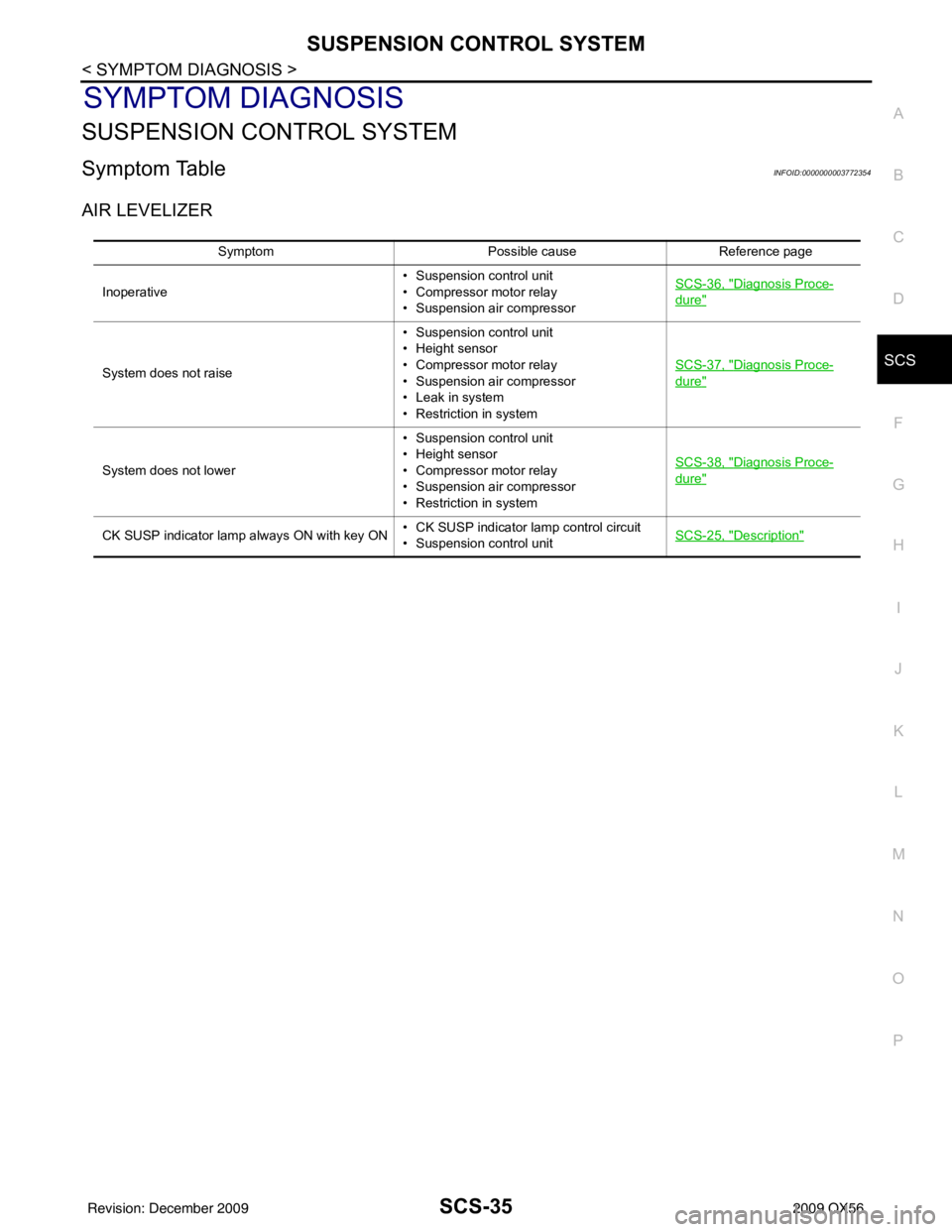2009 INFINITI QX56 key
[x] Cancel search: keyPage 3150 of 4171

RSU-2
< PRECAUTION >
PRECAUTIONS
PRECAUTION
PRECAUTIONS
Precaution for Supplemental Restraint System (SRS) "AIR BAG" and "SEAT BELT
PRE-TENSIONER"
INFOID:0000000005873203
The Supplemental Restraint System such as “A IR BAG” and “SEAT BELT PRE-TENSIONER”, used along
with a front seat belt, helps to reduce the risk or severi ty of injury to the driver and front passenger for certain
types of collision. This system includes seat belt switch inputs and dual stage front air bag modules. The SRS
system uses the seat belt switches to determine the front air bag deployment, and may only deploy one front
air bag, depending on the severity of a collision and w hether the front occupants are belted or unbelted.
Information necessary to service the system safely is included in the SR and SB section of this Service Man-
ual.
WARNING:
• To avoid rendering the SRS inopera tive, which could increase the risk of personal injury or death in
the event of a collision which would result in air bag inflation, all maintenance must be performed by
an authorized NISS AN/INFINITI dealer.
Improper maintenance, including in correct removal and installation of the SRS, can lead to personal
injury caused by unintent ional activation of the system. For re moval of Spiral Cable and Air Bag
Module, see the SR section.
Do not use electrical test equipmen t on any circuit related to the SRS unless instructed to in this
Service Manual. SRS wiring harnesses can be identi fied by yellow and/or orange harnesses or har-
ness connectors.
PRECAUTIONS WHEN USING POWER TOOLS (AIR OR ELECTRIC) AND HAMMERS
WARNING:
When working near the Airbag Diagnosis Sensor Unit or other Airbag System sensors with the Igni-
tion ON or engine running, DO NOT use air or electri c power tools or strike near the sensor(s) with a
hammer. Heavy vibration could activate the sensor( s) and deploy the air bag(s), possibly causing
serious injury.
When using air or electric power tools or hammers , always switch the Ignition OFF, disconnect the
battery, and wait at least 3 minu tes before performing any service.
Precaution Necessary for Steering W heel Rotation After Battery Disconnect
INFOID:0000000005873204
NOTE:
This Procedure is applied only to models with Intelli gent Key system and NATS (NISSAN ANTI-THEFT SYS-
TEM).
Remove and install all control units after disconnecting both battery cables with the ignition knob in the
″LOCK ″ position.
Always use CONSULT-III to perform self-diagnosis as a part of each function inspection after finishing work.
If DTC is detected, perform trouble diagnosis according to self-diagnostic results.
For models equipped with the Intelligent Key system and NATS, an electrically controlled steering lock mech-
anism is adopted on the key cylinder.
For this reason, if the battery is disconnected or if the battery is discharged, the steering wheel will lock and
steering wheel rotation will become impossible.
If steering wheel rotation is required when battery pow er is interrupted, follow the procedure below before
starting the repair operation.
OPERATION PROCEDURE
1. Connect both battery cables. NOTE:
Supply power using jumper cables if battery is discharged.
2. Use the Intelligent Key or mechanical key to turn the ignition switch to the ″ACC ″ position. At this time, the
steering lock will be released.
3. Disconnect both battery cables. The steering lock will remain released and the steering wheel can be
rotated.
4. Perform the necessary repair operation.
Revision: December 20092009 QX56
Page 3180 of 4171

SB-2
< PRECAUTION >
PRECAUTIONS
PRECAUTION
PRECAUTIONS
Precaution for Supplemental Restraint System (SRS) "AIR BAG" and "SEAT BELT
PRE-TENSIONER"
INFOID:0000000005867528
The Supplemental Restraint System such as “A IR BAG” and “SEAT BELT PRE-TENSIONER”, used along
with a front seat belt, helps to reduce the risk or severity of injury to the driver and front passenger for certain
types of collision. This system includes seat belt switch inputs and dual stage front air bag modules. The SRS
system uses the seat belt switches to determine the front air bag deployment, and may only deploy one front
air bag, depending on the severity of a collision and w hether the front occupants are belted or unbelted.
Information necessary to service the system safely is included in the SR and SB section of this Service Man-
ual.
WARNING:
• To avoid rendering the SRS inopera tive, which could increase the risk of personal injury or death in
the event of a collision which would result in air bag inflation, all maintenance must be performed by
an authorized NISSAN/INFINITI dealer.
• Improper maintenance, including in correct removal and installation of the SRS, can lead to personal
injury caused by unintent ional activation of the system. For re moval of Spiral Cable and Air Bag
Module, see the SR section.
• Do not use electrical test equipmen t on any circuit related to the SRS unless instructed to in this
Service Manual. SRS wiring harn esses can be identified by yellow and/or orange harnesses or har-
ness connectors.
PRECAUTIONS WHEN USING POWER TOOLS (AIR OR ELECTRIC) AND HAMMERS
WARNING:
• When working near the Airbag Diagnosis Sensor Unit or other Airbag System sensors with the Igni-
tion ON or engine running, DO NOT use air or electri c power tools or strike near the sensor(s) with a
hammer. Heavy vibration could activate the sensor( s) and deploy the air bag(s), possibly causing
serious injury.
• When using air or electric power tools or hammers , always switch the Ignition OFF, disconnect the
battery, and wait at least 3 minu tes before performing any service.
Precaution Necessary for Steering W heel Rotation After Battery Disconnect
INFOID:0000000005867529
NOTE:
• This Procedure is applied only to models with Intelligent Key system and NATS (NISSAN ANTI-THEFT SYS-
TEM).
• Remove and install all control units after disconnecting both battery cables with the ignition knob in the
″LOCK ″ position.
• Always use CONSULT-III to perform self-diagnosis as a part of each function inspection after finishing work.
If DTC is detected, perform trouble diagnosis according to self-diagnostic results.
For models equipped with the Intelligent Key system and NATS, an electrically controlled steering lock mech-
anism is adopted on the key cylinder.
For this reason, if the battery is disconnected or if the battery is discharged, the steering wheel will lock and
steering wheel rotation will become impossible.
If steering wheel rotation is required when battery pow er is interrupted, follow the procedure below before
starting the repair operation.
OPERATION PROCEDURE
1. Connect both battery cables. NOTE:
Supply power using jumper cables if battery is discharged.
2. Use the Intelligent Key or mechanical key to turn the ignition switch to the ″ACC ″ position. At this time, the
steering lock will be released.
3. Disconnect both battery cables. The steering lock will remain released and the steering wheel can be rotated.
4. Perform the necessary repair operation.
Revision: December 20092009 QX56
Page 3228 of 4171

SUSPENSION CONTROL SYSTEMSCS-35
< SYMPTOM DIAGNOSIS >
C
DF
G H
I
J
K L
M A
B
SCS
N
O P
SYMPTOM DIAGNOSIS
SUSPENSION CONTROL SYSTEM
Symptom TableINFOID:0000000003772354
AIR LEVELIZER
Symptom Possible causeReference page
Inoperative • Suspension control unit
• Compressor motor relay
• Suspension air compressorSCS-36, "
Diagnosis Proce-
dure"
System does not raise • Suspension control unit
• Height sensor
• Compressor motor relay
• Suspension air compressor
• Leak in system
• Restriction in systemSCS-37, "Diagnosis Proce-
dure"
System does not lower
• Suspension control unit
• Height sensor
• Compressor motor relay
• Suspension air compressor
• Restriction in systemSCS-38, "Diagnosis Proce-
dure"
CK SUSP indicator lamp always ON with key ON
• CK SUSP indicator lamp control circuit
• Suspension control unitSCS-25, "Description"
Revision: December 20092009 QX56
Page 3276 of 4171

SE-44
< PRECAUTION >
PRECAUTIONS
PRECAUTION
PRECAUTIONS
Precaution for Supplemental Restraint System (SRS) "AIR BAG" and "SEAT BELT
PRE-TENSIONER"
INFOID:0000000005880168
The Supplemental Restraint System such as “A IR BAG” and “SEAT BELT PRE-TENSIONER”, used along
with a front seat belt, helps to reduce the risk or severity of injury to the driver and front passenger for certain
types of collision. This system includes seat belt switch inputs and dual stage front air bag modules. The SRS
system uses the seat belt switches to determine the front air bag deployment, and may only deploy one front
air bag, depending on the severity of a collision and w hether the front occupants are belted or unbelted.
Information necessary to service the system safely is included in the SR and SB section of this Service Man-
ual.
WARNING:
• To avoid rendering the SRS inopera tive, which could increase the risk of personal injury or death in
the event of a collision which would result in air bag inflation, all maintenance must be performed by
an authorized NISSAN/INFINITI dealer.
• Improper maintenance, including in correct removal and installation of the SRS, can lead to personal
injury caused by unintent ional activation of the system. For re moval of Spiral Cable and Air Bag
Module, see the SR section.
• Do not use electrical test equipmen t on any circuit related to the SRS unless instructed to in this
Service Manual. SRS wiring harn esses can be identified by yellow and/or orange harnesses or har-
ness connectors.
PRECAUTIONS WHEN USING POWER TOOLS (AIR OR ELECTRIC) AND HAMMERS
WARNING:
• When working near the Airbag Diagnosis Sensor Unit or other Airbag System sensors with the Igni-
tion ON or engine running, DO NOT use air or electri c power tools or strike near the sensor(s) with a
hammer. Heavy vibration could activate the sensor( s) and deploy the air bag(s), possibly causing
serious injury.
• When using air or electric power tools or hammers , always switch the Ignition OFF, disconnect the
battery, and wait at least 3 minu tes before performing any service.
Precaution Necessary for Steering W heel Rotation After Battery Disconnect
INFOID:0000000005889885
NOTE:
• This Procedure is applied only to models with Intelligent Key system and NATS (NISSAN ANTI-THEFT SYS-
TEM).
• Remove and install all control units after disconnecting both battery cables with the ignition knob in the
″LOCK ″ position.
• Always use CONSULT-III to perform self-diagnosis as a part of each function inspection after finishing work.
If DTC is detected, perform trouble diagnosis according to self-diagnostic results.
For models equipped with the Intelligent Key system and NATS, an electrically controlled steering lock mech-
anism is adopted on the key cylinder.
For this reason, if the battery is disconnected or if the battery is discharged, the steering wheel will lock and
steering wheel rotation will become impossible.
If steering wheel rotation is required when battery pow er is interrupted, follow the procedure below before
starting the repair operation.
OPERATION PROCEDURE
1. Connect both battery cables. NOTE:
Supply power using jumper cables if battery is discharged.
2. Use the Intelligent Key or mechanical key to turn the ignition switch to the ″ACC ″ position. At this time, the
steering lock will be released.
3. Disconnect both battery cables. The steering lock will remain released and the steering wheel can be rotated.
4. Perform the necessary repair operation.
Revision: December 20092009 QX56
Page 3311 of 4171

SEC-1
BODY EXTERIOR, DOORS, ROOF & VEHICLE SECURITY
C
DE
F
G H
I
J
L
M
SECTION SEC
A
B
SEC
N
O P
CONTENTS
SECURITY CONTROL SYSTEM
WITH INTELLIGENT KEY SYSTEM
BASIC INSPECTION ....... .............................
3
DIAGNOSIS AND REPAIR WORKFLOW ..... .....3
Work Flow ........................................................... ......3
INSPECTION AND ADJUSTMENT .....................6
ADDITIONAL SERVICE WHEN REPLACING
CONTROL UNIT .................................................... ......
6
ADDITIONAL SERVICE WHEN REPLACING
CONTROL UNIT : Special Repair Requirement .......
6
ECM RE-COMMUNICATING FUNCTION ............. ......6
ECM RE-COMMUNICATING FUNCTION : De-
scription .....................................................................
6
ECM RE-COMMUNICATING FUNCTION : Spe-
cial Repair Requirement ............................................
6
FUNCTION DIAGNOSIS ...............................7
INTELLIGENT KEY SYSTEM/ENGINE
START FUNCTIO N ........................................ .....
7
System Diagram .................................................. ......7
System Description ...................................................7
Component Parts Location ........................................9
Component Description ...........................................10
INFINITI VEHICLE IMMOBILIZER SYSTEM-
NATS ..................................................................
11
System Diagram .................................................. ....11
System Description .................................................11
Component Parts Location ......................................13
Component Description ..........................................13
VEHICLE SECURITY SYSTEM .........................15
System Diagram .................................................. ....15
System Description .................................................15
Component Parts Location ......................................16
Component Description ...........................................17
DIAGNOSIS SYSTEM (BCM) ............................18
COMMON ITEM ..................................................... ....18
COMMON ITEM : CONSULT-III Function (BCM -
COMMON ITEM) .....................................................
18
IMMU ...................................................................... ....18
IMMU : CONSULT-III Function (BCM - IMMU) ........18
THEFT ALM ........................................................... ....19
THEFT ALM : CONSULT-III Function (BCM -
THEFT ALM) ....................................................... ....
19
DIAGNOSIS SYSTEM (INTELLIGENT KEY
UNIT) .................................................................
20
CONSULT-III Function (INTELLIGENT KEY) ..........20
COMPONENT DIAGNOSIS .........................22
U1000 CAN COMM CIRCUIT ...........................22
Description ........................................................... ....22
DTC Logic ................................................................22
Diagnosis Procedure ...............................................22
U1010 CONTROL UNIT (CAN) .........................23
Description ...............................................................23
DTC Logic ................................................................23
Diagnosis Procedure ...............................................23
Special Repair Requirement ....................................23
B2013 ID DISCORD I-KEY-STRG ....................24
Description ...............................................................24
DTC Logic ................................................................24
Diagnosis Procedure ...............................................24
B2190, P1614 NATS ANTENNA AMP. ............27
Description ...............................................................27
DTC Logic ................................................................27
Diagnosis Procedure ...............................................27
B2191, P1615 DIFFERENCE OF KEY .............30
Description ...............................................................30
DTC Logic ................................................................30
Diagnosis Procedure ...............................................30
Revision: December 20092009 QX56
Page 3312 of 4171

SEC-2
B2192, P1611 ID DISCORD, IMMU-ECM .........31
Description ........................................................... ...31
DTC Logic ...............................................................31
Diagnosis Procedure ..............................................31
B2193, P1612 CHAIN OF ECM-IMMU ..............33
Description ........................................................... ...33
DTC Logic ...............................................................33
Diagnosis Procedure ..............................................33
B2194 ID DISCORD IMMU-I-KEY .....................34
Description ........................................................... ...34
DTC Logic ...............................................................34
Diagnosis Procedure ..............................................34
B2552 INTELLIGENT KEY ................................35
Description ........................................................... ...35
DTC Logic ...............................................................35
Diagnosis Procedure ..............................................35
Special Repair Requirement ...................................35
B2590 ID DISCORD BCM-I-KEY .................... ...36
Description ........................................................... ...36
DTC Logic ...............................................................36
Diagnosis Procedure ..............................................36
P1610 LOCK MODE ..........................................37
Description ........................................................... ...37
DTC Logic ...............................................................37
Diagnosis Procedure ..............................................37
POWER SUPPLY AND GROUND CIRCUIT .....38
INTELLIGENT KEY UNIT ...................................... ...38
INTELLIGENT KEY UNIT : Diagnosis Procedure ...38
BCM ........................................................................ ...38
BCM : Diagnosis Procedure ...................................38
KEY CYLINDER SWITCH .................................40
Description ........................................................... ...40
Component Function Check ...................................40
Diagnosis Procedure ..............................................40
IGNITION KNOB SWITCH .................................42
Ignition Knob Switch Check ................................. ...42
HOOD SWITCH .................................................44
Diagnosis Procedure ..............................................44
HORN FUNCTION .............................................46
Symptom Table ................................................... ...46
VEHICLE SECURITY INDICATOR ....................47
Description ........................................................... ...47
Component Function Check .................................47
Diagnosis Procedure ..............................................47
ECU DIAGNOSIS ..................................... ...49
BCM (BODY CONTROL MODULE) ............... ...49
Reference Value .................................................. ...49
Terminal Layout ......................................................51
Physical Values .......................................................51
Wiring Diagram - VEHICLE SECURITY SYSTEM ...57
Wiring Diagram - IVIS .............................................68
Fail Safe .................................................................76
DTC Inspection Priority Chart ...............................77
DTC Index ..............................................................77
INTELLIGENT KEY UNIT ..................................79
Reference Value - Intelligent Key Unit ................. ...79
Reference Value - Steering Lock Solenoid .............82
Wiring Diagram - INTELLIGENT KEY SYSTEM/
ENGINE START FUNCTION - ................................
83
Fail Safe .................................................................95
DTC Inspection Priority Chart ...............................95
DTC Index ..............................................................95
IPDM E/R (INTELLIGENT POWER DISTRI-
BUTION MODULE ENGINE ROOM) .................
96
Reference Value .................................................. ...96
Terminal Layout ......................................................98
Physical Values .......................................................98
Fail Safe ...............................................................102
DTC Index ............................................................103
SYMPTOM DIAGNOSIS ...........................104
INTELLIGENT KEY SYSTEM/ENGINE
START FUNCTION SYMPTOMS ................... ..
104
Symptom Table .................................................... .104
VEHICLE SECURITY SYSTEM SYMPTOMS ..105
Symptom Table .....................................................105
INFINITI VEHICLE IMMOBILIZER SYSTEM-
NATS SYMPTOMS ...........................................
106
Symptom Table .................................................... .106
ON-VEHICLE MAINTENANCE .................107
PRE-INSPECTION FOR DIAGNOSTIC ......... ..107
Basic Inspection ................................................... .107
Vehicle Security Operation Check ........................107
PRECAUTION ...........................................109
PRECAUTIONS .............................................. ..109
Precaution for Supplemental Restraint System
(SRS) "AIR BAG" and "SEAT BELT PRE-TEN-
SIONER" .............................................................. .
109
Precaution Necessary for Steering Wheel Rota-
tion After Battery Disconnect ................................
109
ON-VEHICLE REPAIR ..............................111
VEHICLE SECURITY SYSTEM ...................... ..111
Removal and Installation .......................................111
Revision: December 20092009 QX56
Page 3313 of 4171
![INFINITI QX56 2009 Factory Service Manual DIAGNOSIS AND REPAIR WORKFLOWSEC-3
< BASIC INSPECTION > [WITH INTELLIGENT KEY SYSTEM]
C
D
E
F
G H
I
J
L
M A
B
SEC
N
O P
BASIC INSPECTION
DIAGNOSIS AND REPAIR WORKFLOW
Work FlowINFOID:0000000003775864
INFINITI QX56 2009 Factory Service Manual DIAGNOSIS AND REPAIR WORKFLOWSEC-3
< BASIC INSPECTION > [WITH INTELLIGENT KEY SYSTEM]
C
D
E
F
G H
I
J
L
M A
B
SEC
N
O P
BASIC INSPECTION
DIAGNOSIS AND REPAIR WORKFLOW
Work FlowINFOID:0000000003775864](/manual-img/42/57031/w960_57031-3312.png)
DIAGNOSIS AND REPAIR WORKFLOWSEC-3
< BASIC INSPECTION > [WITH INTELLIGENT KEY SYSTEM]
C
D
E
F
G H
I
J
L
M A
B
SEC
N
O P
BASIC INSPECTION
DIAGNOSIS AND REPAIR WORKFLOW
Work FlowINFOID:0000000003775864
OVERALL SEQUENCE
DETAILED FLOW
ALKIA0538GB
Revision: December 20092009 QX56
Page 3314 of 4171
![INFINITI QX56 2009 Factory Service Manual SEC-4
< BASIC INSPECTION >[WITH INTELLIGENT KEY SYSTEM]
DIAGNOSIS AND REPAIR WORKFLOW
1.GET INFORMATION FOR SYMPTOM
Get the detailed information from the customer about the symptom (the condition and INFINITI QX56 2009 Factory Service Manual SEC-4
< BASIC INSPECTION >[WITH INTELLIGENT KEY SYSTEM]
DIAGNOSIS AND REPAIR WORKFLOW
1.GET INFORMATION FOR SYMPTOM
Get the detailed information from the customer about the symptom (the condition and](/manual-img/42/57031/w960_57031-3313.png)
SEC-4
< BASIC INSPECTION >[WITH INTELLIGENT KEY SYSTEM]
DIAGNOSIS AND REPAIR WORKFLOW
1.GET INFORMATION FOR SYMPTOM
Get the detailed information from the customer about the symptom (the condition and the environment when
the incident/malfunction occurred).
>> GO TO 2
2.CHECK DTC
1. Check DTC for Intelligent Key unit and BCM.
2. Perform the following procedure if DTC is displayed.
- Erase DTC.
- Study the relationship between the cause detected by DTC and the symptom described by the customer.
3. Check related service bulletins for information.
Is any symptom described and any DTC detected?
Symptom is described, DTC is displayed>>GO TO 3
Symptom is described, DTC is not displayed>>GO TO 4
Symptom is not described, DTC is displayed>>GO TO 5
3.CONFIRM THE SYMPTOM
Confirm the symptom described by the customer.
Connect CONSULT-III to the vehicle in “DATA MO NITOR” mode and check real-time diagnosis results.
Verify relation between the symptom and the condition when the symptom is detected.
>> GO TO 5
4.CONFIRM THE SYMPTOM
Confirm the symptom described by the customer.
Connect CONSULT-III to the vehicle in “DATA MO NITOR ” mode and check real-time diagnosis results.
Verify relation between the symptom and the condition when the symptom is detected.
>> GO TO 6
5.PERFORM DTC CONFIRMATION PROCEDURE
Perform DTC Confirmation Procedure for the display ed DTC, and then check that DTC is detected again.
If two or more DTCs are detected, refer to SEC-95, "
DTCInspectionPriorityChart" (Intelligent Key unit),
SEC-77, "
DTCInspectionPriorityChart" (BCM) and determine trouble diagnosis order.
Is DTC detected?
YES >> GO TO 8
NO >> Refer to GI-38, "
Intermittent Incident".
6.PERFORM BASIC INSPECTION
Perform Basic Inspection. Refer to SEC-107, "
Basic Inspection".
>> GO TO 7
7.DETECT MALFUNCTIONING SYSTEM BY SYMPTOM TABLE
Detect malfunctioning system according to Symptom Table based on the confirmed symptom in step 4.
>> GO TO 8
8.DETECT MALFUNCTIONING PART BY DIAGNOSTIC PROCEDURE
Inspect according to Diagnostic Procedure of the system.
NOTE:
The Diagnostic Procedure is described based on open circuit inspection. A short circuit inspection is also
required for the circuit check in the Diagnostic Procedure.
>> GO TO 9
Revision: December 20092009 QX56